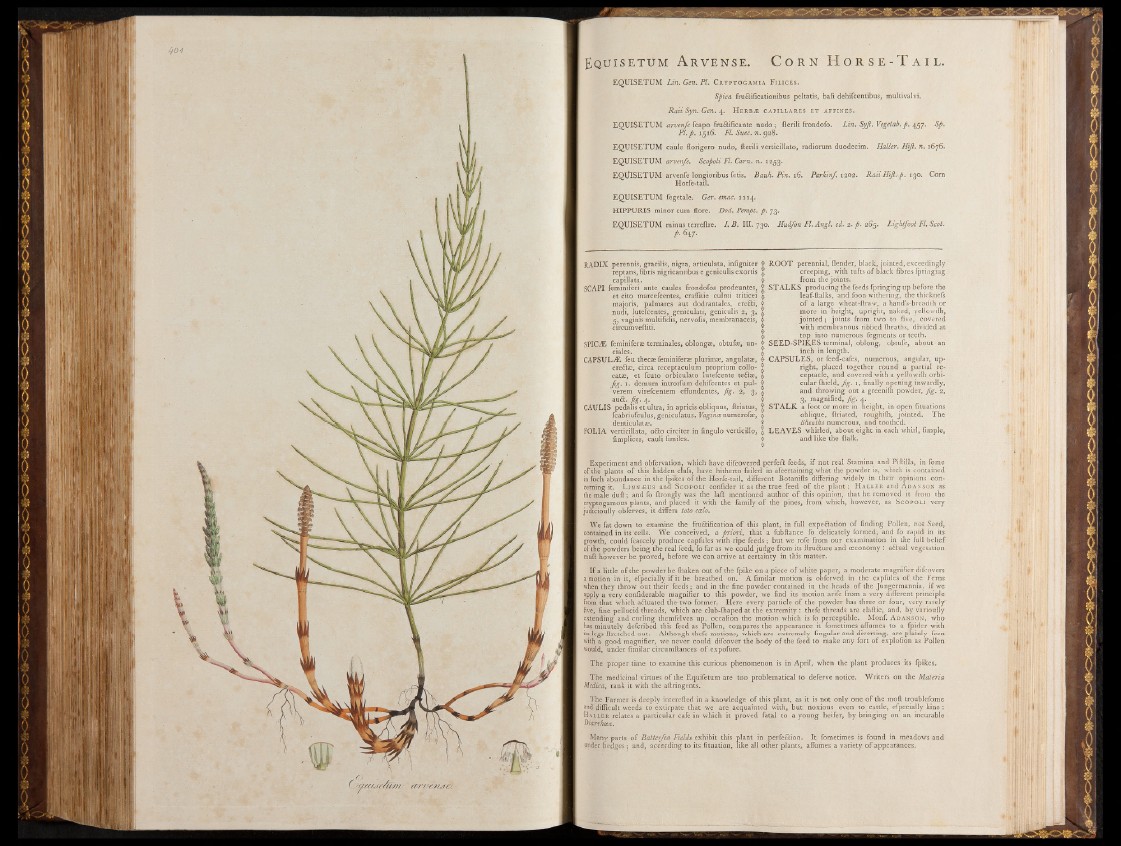
Equi s e tüm A r v e n s e . C o r n H o r s e - T a i l ,
EQUISETUM Lin. Gen. Pl. C ryptogamia Filices.
Spica fru&ificationibus peltatis, bafi dehifcentibus, multivalvi.
Raii Syn. Gen. 4. Herbve capillares et affines.
EQUISETUM arvenfe fcapo fruftificante nudo; fterili frondofo. Lin. Syß. Vegetab. p. 457. Sp.
Pl.ß. 1516. FL. Suec. n. 928.
EQUISETUM caule florigero nudo, fterili verticillato, radiorum duodecim. Haller. Hiß. n. 1676.
EQUISETUM arvenfe. Scopoli Fl. Carn. n. 1253.
EQÜISETUM arvenfe longioribus fetis. Bauh.Pin. 16. Parkirf. 1202. RaiiHiß.'ß. 130. Com
Horfe-tail.
EQUISETUM fegetale. Ger.emac. 1114.
HIPPURIS minor cum flore. Dod. Pempt. p. 73.
EQUISETUM minus terreftre. I. B. III. 730. Hutfon Fl. Angl. ed. 2. p. 265. Lightfoot FL Scöt.
p- 647.
RADIX perennis, gracilis, nigra, articulata, infigniter $
reptans, fibris nigricantibus e geniculis exortis *
: 1 capillata. $
5CAPI femmiferi ante caules frondofos prodeuntes, |
et cito marcefcentes, craffitie culmi triticei $
majoris, palmares aut dodrantales, ere6ti, f
jaudi, lutefcentes, geniculati, geniculis 2, 3, %
5, vaginis multifidis, nervofis, membranaceis, $
f -circumveftiti. ^
SPICKE feminiferas terminales, oblongse, obtufae, un- &
ciales.
CAPSULAL feu thecae feminiferae plurimae, angulatae,
ereftae, circa receptaculum proprium collo- §
catae, et fcuto orbiculato lutefcente teftae, $
ßg. 1. demum introrfum dehifcentes et pul- $
verem virefcentem effundentes, ßg. 2, 3, %
auft. ßg. 4. f
CAULIS pedalis et ultra, in apricis obliquus, ftriatus, |
fcabriufculus, genicufatus. Vaginae numerofae, $
, denticulatae.
FOLIA verticillata, o&o circiter in fingulo verticillo, $
ßmplices, cauli fimiles.
ROOT perennial, {lender, black, jointed, exceedingly
creeping, with tufts of black fibres fpringing
from the joints.
STALKS producing the feeds fpringing up before the
leaf-ftalks, and foon withering, the thicknefs
of a large wheat-ftraw, a hand’s-breadth or
more in height, upright, naked, yellowifh,
jointed; joints from two to five, covered
with membranous ribbed {heaths, divided at
top into numerous fegments or teeth.
SEED-SPIKES terminal, oblong, obtufe, about an
inch in length.
CAPSULES, or feed-cafes, numerous, angular, upright,
placed together round a partial receptacle,
and covered with a yellowifh orbicular
fhield, Jig. 1, finally opening inwardly,
and throwing out a greenim powder, fig. 2,
3, magnified, fig. 4.
STA LK a foot or more in height, in open fituations
oblique, ftriated, roughilh, jointed. The
Sheaths numerous, and toothed.
LEAVES whirled, about eight in each whirl, Ample,
and like the ftalk.
Experiment and obfervation, which have difcovered perfe& feeds, if not real Stamina and Piftilla, in fome
of the plants of this hidden clafs, have hitherto failed in afcertaining what the powder is, which is contained
in fach abundance in the fpikes of the Horfe-tail, different Botanifts differing widely in their opinions concerning
it. L innaeus and Scopoli confider it as the true feed o f the plant; Haller and A danson as
the male duft; and fo ftrongly was the I aft mentioned author of this opinion, that he removed it from the
cryptogamous plants, and placed it with the family of the pines, from which, however, as Scopoli very
judicioufly obferves, it differs toto cxlo.
We fat down to examine the fru&ification o f this plant, in full expe&ation of finding Pollen, not Seed,
contained in its‘cells. We conceived, a priori, that a fubftance fo delicately formed; and fo rapid in its
growth, could fcarcely produce capfules with ripe feeds ; but we rofe from our examination in the full belief
of the powders being the real feed, fo far as we could judge from its ftrufture and ceconomy : aftual vegetation
muft however be proved, before we can arrive at certainty in this matter.
If a little of the powder be fhaken out o f the fpike on a piece of white paper, a moderate magnifier difcovers
a motion in it, efpecially if it be breathed on. A fimilar motion is obferved in the capfules o f the Ferns
when they throw out their feeds ; and in the fine powder contained in the heads of the Jungermannia, if we
apply a very confiderable magnifier to this powder, we find its motion arife from a very different principle
from that which aftuated the-two former. Here every particle of the powder has three or four, very rarely
jive, fine pellucid threads, which are club-fhaped at the extremity : thefe threads are elaftic, and, by varioufly
extending and curling themfelves up. occafion the motion which is fo perceptible. Monf. A danson, who
has minutely defcribed this feed as Pollen, compares the appearance it fometimes affumes to a fpider with
its legs ftretched out. Although thefe motions, which are extremely lingular and diverting, are plainly feen
with a good magnifier, we never could difcover the body of the feed to make any fort of explofion as Pollen
would, under fjmiJar circumftances of expofure.
The proper time to examine this curious phenomenon is in April, when the plant produces its fpikes.
The medicinal virtues of the Equifetum are too problematical to deferve notice. Writers on the Materia
Medica, rank it with the aftringents.
The Farmer is deeply interefted in a knowledge of this plant, as it is not only one of the moft troublefome
and difficult weeds to extirpate that we are acquainted with, but noxious even to cattle, efpecially kine :
Haller relates a particular cafe in which it proved fatal to a young heifer, by bringing on an incurable
Liarrhcea.
Many parts of Batterfea Fields exhibit this plant in perfe£iion. It fometimes is found in meadows and
Ppder hepges; and, according to its fituation, like all other plants, affumes a variety of appearances.